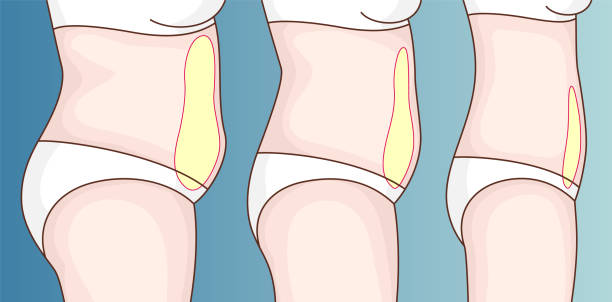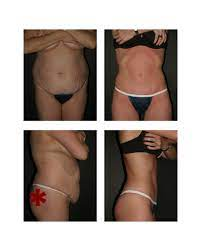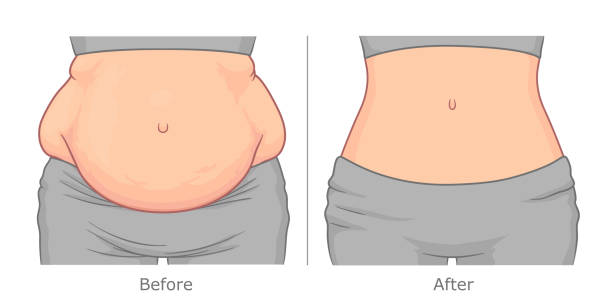What’s the difference between visceral fat and subcutaneous fat?

What is visceral fat?
Visceral fat is the fat that surrounds your organs. It’s located deep inside your body, around your stomach and organs. This type of fat is dangerous because it can contribute to various health problems, including heart disease, high blood pressure, and type 2 diabetes. Visceral fat is considered “active” because it releases hormones and other chemicals that can affect your health. This dangerous visceral fat means that even if you’re not overweight, having too much visceral fat can still be harmful.
What is subcutaneous fat?
Subcutaneous fat is the fat that lies just beneath your skin. It’s the only body fat you can pinch and see. This type of fat is not as dangerous as visceral fat but can still contribute to health problems if you have too much of it. Generally, subcutaneous fat is more of a cosmetic than a health issue. The fat contributes to “love handles” or a “muffin top.”
What’s the difference between visceral fat and subcutaneous fat?
The main difference between visceral fat and subcutaneous fat is its location in the body. While both types of fat can contribute to health problems, visceral visceral and subcutaneous fat is considered more dangerous because of its location around the organs. Another difference between the two types of fat is that more visceral fat also tends to be more metabolically active. This means it can release more hormones and chemicals into the body, contributing to health problems.
Why is it important to understand the difference?
Understanding the difference between your visceral fat stores and subcutaneous fat is important because they have different health implications and weight loss strategies. If you want to lose weight and improve your health, reducing the visible fat under your skin is not enough. It would be best if you also targeted the visceral fat lurking inside your body. Research suggests that a diet low in carbohydrates and high in healthy fats effectively reduces visceral fat.
How do you get rid of visceral fat?
Start by making some healthy and sustainable lifestyle changes, such as:
a. Eating a balanced diet: Ensure you eat various fruits, vegetables, lean protein, and healthy fats. Avoid eating processed and high-sugar foods.
b. Regular exercise: Physical activity is vital in reducing visceral fat. Aim for 30 minutes of moderate-intensity exercise at least five times a week.
c. Get enough sleep: Lack of sleep can lead to weight gain and visceral fat accumulation.
d. Reduce stress: Chronic stress can lead to higher cortisol levels, increasing visceral fat accumulation cardiovascular risk factors.
What Not to Do?
Here are some of the things you should not all fat and should NOT do when trying to get rid of visceral fat:
a. Starving yourself: Avoid cutting down your caloric intake significantly. A drastic reduction in calories can lead to losing muscle mass, which is the last thing you want.
b. Relying only on Cardio: While cardio exercises are great, lifting weights is just as important, if not more, for reducing visceral fat.
c. Drinking too much alcohol: Drinking alcohol can lead to belly fat accumulation and harm your overall health, so it’s better to limit your alcohol intake.

What is the best surgery for stomach fat?
If you have been working hard to lose excess weight around your stomach to no avail, you may be considering surgery to eliminate that persistent abdominal fat around. However, you may be curious about the options available and which is the best for you. We understand that the process can be quite tricky, so we want to delve into the different types of surgeries for stomach fat reduction to help you make an informed decision.
1. Liposuction Surgery
Liposuction is one of the popular surgeries for removing belly fat. The process involves suctioning fat through a cannula by creating small incisions in the targeted area. This surgery is best suited for individuals with lower body mass index than those with high BMI. The ideal candidate for liposuction is in great health and is willing to heed the post-surgery guidelines to avoid complications.
2. Tummy Tuck Surgery
Tummy tuck surgery involves the removal of excess fat and skin from the abdominal area. It is ideal for people who have lost considerable weight and have saggy skin or those with multiple folds of fat. The surgery requires an incision on the lower part of the abdomen, after which the surgeon will remove excess skin and tighten the abdominal muscles. The process also involves repositioning the belly button.
3. CoolSculpting
CoolSculpting is a non-surgical procedure that involves using cooling temperatures to freeze and kill fat cells. The dead cells are naturally eliminated through the body’s lymphatic system. With this method, there is no need for incisions or anesthesia, making the process painless and less invasive. However, it may take six to eight weeks to notice the results, and a few additional treatments may be necessary.
4. Gastric Bypass Surgery
Gastric bypass surgery is a weight loss procedure that involves the creation of a small pouch from the stomach and abdominal cavity. The small intestine is redirected to this pouch to reduce the amount of food that can be consumed. Gastric bypass surgery helps not only in reducing stomach fat but also improving weight-related health issues. However, this permanent and irreversible procedure should only be done once other weight-loss methods fail.
5. Weight Loss Medications
While not necessarily a surgical option, medical weight-loss treatments can be used by individuals when other methods have proven difficult. Medications such as Phentermine or topiramate can suppress appetite and promote weight loss. Medications can be prescribed by a licensed medical professional and should be used only under supervision.

What is the difference between a tummy tuck and liposuction?
Tummy tucks, or abdominoplasty, is a surgical procedure that removes excess fat and skin from the abdominal area. This procedure is typically recommended for those who have lost significant weight or women who have had multiple pregnancies. During a tummy tuck, an incision is made from hipbone to hipbone, and the skin and fat are removed, followed by the tightening of abdominal muscles. A tummy tuck is a more invasive procedure than liposuction and may require a longer recovery.
Liposuction is a less invasive procedure that involves the removal of excess fat through a small incision and using a suction device. The procedure is typically recommended for those at or near their ideal weight but have stubborn pockets of fat in certain areas. It is not recommended as a weight-loss method but as a complement to a healthy lifestyle. Liposuction can be performed on various body parts, including the stomach, hips, thighs, arms, and buttocks.
Both tummy tucks and liposuction have advantages and disadvantages, so it is essential to weigh them carefully before deciding. Tummy tucks are typically more expensive and invasive, with a more extended recovery period. However, they may be more effective in removing excess skin and tightening the abdominal muscles. Liposuction is a less expensive and less invasive option with a shorter recovery period. It is also more versatile and can be performed on various body parts.

What plastic surgery makes your stomach flat?
There are two main plastic surgery types intended to flatten your stomach. The first is liposuction, which involves removing excess fat deposits from the stomach area using a tube inserted under the skin. Liposuction is a relatively low-risk procedure and can provide the appearance of weight loss or give your body contours a more appealing look. The second type of plastic surgery is a tummy tuck, which involves removing excess skin, fat and tightening muscles in the abdominal area. Tummy tucks are more invasive than liposuction and require a longer recovery time. However, both surgeries can lead to a flatter stomach. It’s always essential to consult with licensed practitioners, review the potential risks, and be aware of the costs involved before deciding to undergo a procedure. It can improve your appearance and give you confidence, but only if you’re fully informed about the process and the potential consequences.
How to Ensure the Best Results from Tummy Tuck or Liposuction
1. Consult with a Board-Certified Surgeon:
The first and most crucial step in ensuring a successful tummy tuck or liposuction is to find a qualified and experienced surgeon. Choose a board-certified surgeon who has a good reputation for performing these procedures. Schedule a consultation with the surgeon and ask any questions you may have. Your surgeon will examine your body and discuss the expected results, the risks involved, and any limitations that may affect your outcome.
2. Follow Pre-Operative Guidelines:
Before the surgery, your surgeon will provide you with pre-operative guidelines, including dietary and lifestyle recommendations. If you have a medical condition that requires medication, inform your surgeon so that proper adjustments can be made. Follow the prescribed guidelines strictly to increase your chances of a smooth operation and quick recovery.
3. Take Time to Rest and Recover:
Recovery time is crucial after a tummy tuck or liposuction. Your body needs time to heal; excessive activity can hinder the healing process and delay your results. Take time off work and other activities to allow your body to rest and recover. Follow the post-operative guidelines provided by the surgeon, including wearing compression garments and avoiding strenuous exercises or activities.
4. Maintain a Healthy Lifestyle:
A tummy tuck or liposuction is not a substitute for a healthy lifestyle. You need to maintain a healthy diet and exercise regimen to ensure lasting results. Eat a balanced diet that includes whole grains, fruits, and vegetables, and avoid processed food, sugar, and saturated fats. Exercise regularly, including both cardio and strength-training exercises, to maintain muscle tone and avoid weight gain in the future.
5. Attend Follow-up Appointments:
Your surgeon will schedule several follow-up appointments to monitor your progress and assess your healing. Attend all scheduled appointments and inform your surgeon of any concerns or issues. Your surgeon may recommend additional procedures or therapies to enhance your results and ensure your satisfaction.
Can visceral fat have an impact on surgeries?
Excess visceral fat can make surgeries more complicated in several ways:
- It can make it more difficult for surgeons to visualize and access the organs they need to operate on, increasing the risk of complications.
- Visceral fat can interfere with the healing process, as it can lead to inflammation and impair the body’s ability to heal after surgery.
- Excess visceral fat can increase the risk of post-surgical infections, as it can create a breeding ground for harmful bacteria.
How Much Visceral Fat to Reduce Before Surgery ?
If you’re planning to undergo surgery soon, it’s important to reduce your visceral fat levels to help ensure a successful outcome. One of the most effective ways to reduce visceral fat is by losing weight through a combination of healthy eating and regular exercise. In particular, high-intensity interval training (HIIT) is an effective way to reduce visceral fat levels. Other lifestyle changes that can help reduce visceral fat include getting plenty of sleep, managing stress, and avoiding sugary and processed foods.
The Importance of Discussing Visceral Fat with Your Surgeon
If you’re a weight loser and are planning to undergo surgery, it’s essential to talk to your surgeon about your visceral fat levels. Your surgeon can help assess the risks associated with excess visceral fat and provide guidance on how to reduce its impact on your surgery. Additionally, your surgeon may recommend delaying your surgery until you’ve had time to reduce your visceral fat levels.

How much belly fat can be removed with a tummy tuck?
A tummy tuck is a surgical procedure that removes excess skin and fat from the abdomen area. The surgery involves making incisions on the stomach and tightening the muscles underneath. The amount of belly fat that can be removed during a tummy tuck varies depending on individual factors for many patients, such as age, weight, and the amount of excess skin and fat in the abdominal area.
On average, a tummy tuck can remove about 6 to 10 pounds of belly fat. However, it’s important to note that the primary objective of this surgery is not to lose total body weight but to remove excess skin and fat. A tummy tuck is recommended for people who have lost significant weight and are left with excess skin and fat that diet and exercise cannot remove.
The amount of belly fat that can be removed during a tummy tuck also depends on the type of tummy tuck performed. The two most popular types of tummy tucks are a full tummy tuck and a mini tummy tuck. A full tummy tuck removes more skin and fat than a mini tummy tuck. A mini tummy tuck is recommended for those who have a small amount of excess skin and fat in the lower abdominal region.
It’s also important to note that a tummy tuck is not a one-time solution to get a flat stomach. Maintaining a healthy lifestyle with a balanced diet and exercise is essential for maintaining the results of the surgery. Additionally, if you gain weight after the surgery, the results of the tummy tuck may not be as apparent.

Book Your Plastic Surgery Consultation
Identify a reputable plastic surgeon you’d like to work with in your area. Look up their credentials, education, experience, and reviews from their previous clients. This is an essential first step. Once you’ve found a prospective surgeon, it’s time to book a consultation.
Consultations are the perfect opportunity to get to know your surgeon and clarify any questions or concerns you may have. During the consultation, your surgeon will ask about your ideal outcome and recommend the best treatment plan for you. They will walk you through the procedures, identify the risks, and inform you about the recovery period.
After consulting with your surgeon, you can then decide if you want to proceed with the surgery. If yes, schedule a date for the procedure. At this point, your surgeon will give you pre-operative instructions, including not smoking, eating a balanced diet, and staying hydrated.
On the day of the surgery, you’ll need to prepare by wearing comfortable and loose-fitting clothing. Make sure to have arranged for a responsible adult to drive you back home after the procedure since you won’t be able to drive under the influence of anesthesia.
Once the surgery is complete, you’ll be given specific post-operative instructions to follow. It’s essential to adhere to those instructions to hasten the recovery process, which can take up to six weeks. During this period, you’ll need to avoid exercise, lifting weights, and anything that puts undue pressure on the treated area.


Leave a Reply